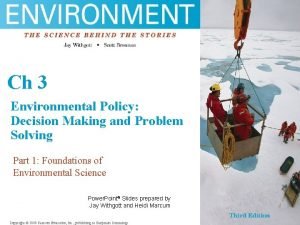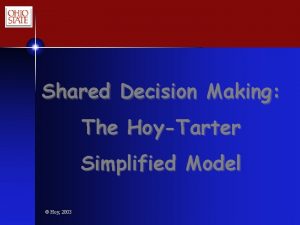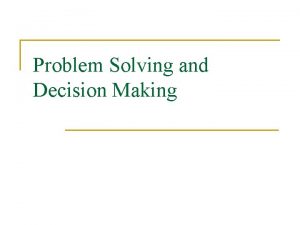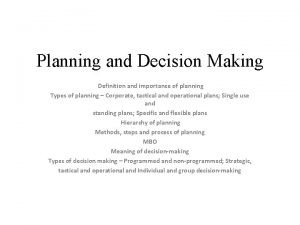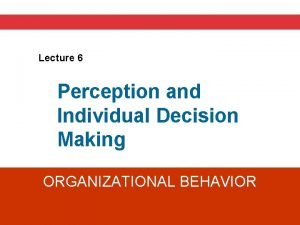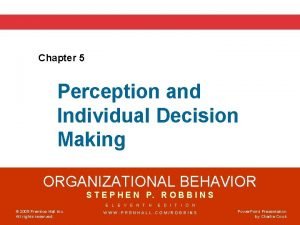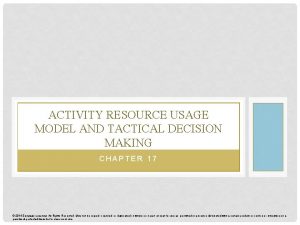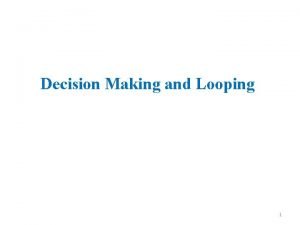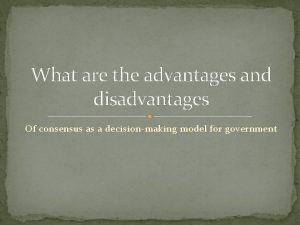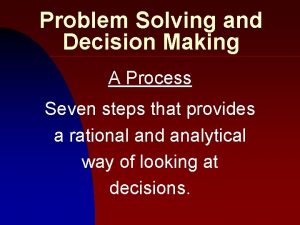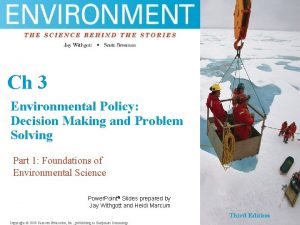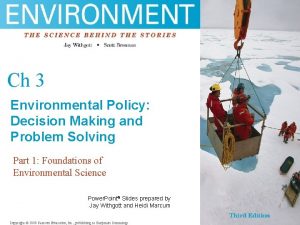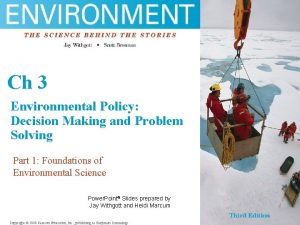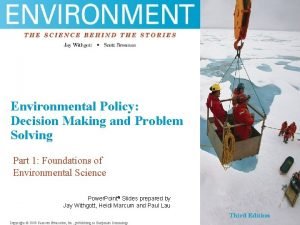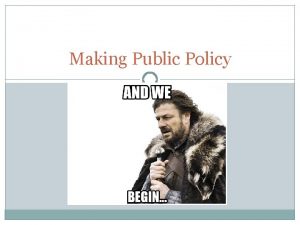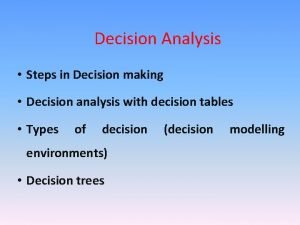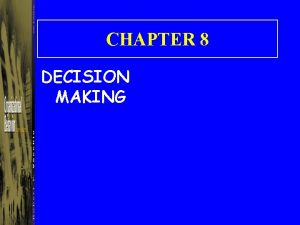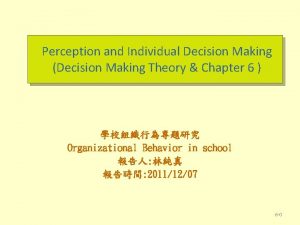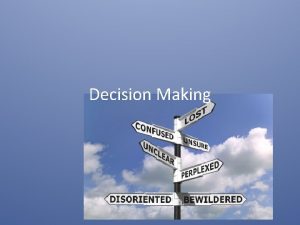Chfgh 3 Environmental Policy sfg Decision Making and







































- Slides: 39

Chfgh 3 Environmental Policy: sfg Decision Making and Problem Solving dfg Part 1: Foundations of Environmental Science Power. Point® Slides prepared by Jay Withgott and Heidi Marcum Copyright © 2006 Pearson Education, Inc. , publishing as Benjamin Cummings Copyright © 2008 Pearson Education, Inc. , publishing as Benjamin Copyright © 2008 Pearson Education, publishing as Pearson. Cummings Benjamin Cummings

This lecture will help you understand: • Environmental policies • Major U. S. environmental laws • International environmental policy • The environmental policy process • Different approaches to environmental policy Copyright © 2008 Pearson Education, Inc. , publishing as Pearson Benjamin Cummings Tijuana(Mex. ) / San. Diego (Cal. )

San Diego and Tijuana • The Tijuana River empties into the Pacific Ocean, carrying millions of gallons of untreated wastewater • San Diego’s waters receive storm water runoff • Beaches are off-limits to swimming • Rains wash pollutants onto U. S. and Mexican beaches, but things are worse on the Mexican side Copyright © 2008 Pearson Education, Inc. , publishing as Pearson Benjamin Cummings

Environmental policy • Policy: a formal set of general plans and principles to address problems and guide decisions • Public Policy: policy made by governments that consists of laws, regulations, orders, incentives, and practices • Environmental Policy: pertains to human interactions with the environment • Regulates resource use or reduce pollution for sustainable development - Local, National, Global (International) Copyright © 2008 Pearson Education, Inc. , publishing as Pearson Benjamin Cummings

Why are environmental laws unpopular? • Environmental laws are challenged, derided, and ignored • Environmental policy involves government regulations - Businesses and individuals view laws as overly restrictive and unresponsive to human needs • Most environmental problems are long-term processes - Human behavior is geared toward short-term needs - News media have short attention spans - Politicians act out of their own short-term interest “An Inconvenient Truth”, Al Gore, NP(2007) → Library Copyright © 2008 Pearson Education, Inc. , publishing as Pearson Benjamin Cummings

Framework of U. S. policy • Results from actions of the three branches of government • Legislative branch = creates statutory law • Executive branch = enacts or vetoes legislation - Issues executive orders • Judicial branch = interprets laws • Administrative agencies = the “fourth branch” - Established by the president or Congress Copyright © 2008 Pearson Education, Inc. , publishing as Pearson Benjamin Cummings

State and local policies affect environmental issues • Important environmental policy is also created at the state and local levels • State laws cannot violate principles of the U. S. Constitution, • If laws conflict, federal laws take precedence • California, New York, and Massachusetts have strong environmental laws • The interior western states put less priority on environmental protection and favor unregulated development Copyright © 2008 Pearson Education, Inc. , publishing as Pearson Benjamin Cummings

Early U. S. environmental policy : First Wave in late 18 th C • Independence: 1776 • Involved management of public lands, 1780 s to the late 1800 s • Promoted settlement • Extraction of natural resources • Increased prosperity • Relieved crowding in Eastern cities • Displaced millions of Native Americans • People believed that land was infinite and inexhaustible Copyright © 2008 Pearson Education, Inc. , publishing as Pearson Benjamin Cummings

The second wave of U. S. policy: started in mid-19 th C • Addressed impacts caused by the first wave • Public perception and government policy shifted - Mitigated environmental problems associated with westward expansion - Yellowstone National Park, the world’s first national park, opened in 1872 - Yosemite National Park, established in 1890 • Other protected areas were created - National wildlife refuges (1903) parks, and forests • Reflected a new understanding that the West’s resources were exhaustible and required legal protection Copyright © 2008 Pearson Education, Inc. , publishing as Pearson Benjamin Cummings

The third wave of U. S. environmental policy: mid-20 th C Better off economically, but dirtier air & water, & more waste & toxic chemicals Fires on Cayahoga River in 50 s & 60 s (Cleveland/Akron area) • Increased awareness of environmental problems shifted public priorities and policy • 1962: Silent Spring (by Rachel Carson) described the negative ecological and health effects of pesticides and industrial chemicals 1996: Our Stolen Future (Theo Colborn, Dianne Dumanoski, John Peterson Myers of World Wildlife Fund) – some synthetic chemicals disrupt hormonal systems to cause of abnormalities in animals. Copyright © 2008 Pearson Education, Inc. , publishing as Pearson Benjamin Cummings

The National Environmental Policy Act (NEPA) • 1970 began the modern era of environmental policy • Created the Council on Environmental Quality - Requires an Environmental Impact Statement (EIS) for any federal action that might impact the environment NEPA forces the government and businesses to evaluate the environmental impacts of a project Copyright © 2008 Pearson Education, Inc. , publishing as Pearson Benjamin Cummings

The EPA shifts environmental policy • Nixon created the Environmental Protection Agency (EPA) • Conducts and evaluates research • Monitors environmental quality • Sets and enforces standards for pollution levels • Assists states in meeting standards and goals • Educates the public Copyright © 2008 Pearson Education, Inc. , publishing as Pearson Benjamin Cummings

Significant environmental laws • The public demanded a cleaner environment and supported tougher environmental legislation Copyright © 2008 Pearson Education, Inc. , publishing as Pearson Benjamin Cummings

The Earth Summit : - 4 th Wave (Global) in 2, 000 s Rio de Janeiro, Brazil, in 2002 • The largest international diplomatic conference ever held - It centered on policy for the idea of sustainable development - Finding ways to safeguard natural systems while raising living standards for the world’s poorest people Copyright © 2008 Pearson Education, Inc. , publishing as Pearson Benjamin Cummings

International Environmental Policy • International issues can be addressed through creative agreements • Customary law: practices or customs held by most cultures • Conventional law = from conventions or treaties - Montreal Protocol: nations An international wastewater agreed to reduce ozonetreatment plant (US/Mexico) depleting chemicals (1987) → very successful - Kyoto Protocol (1997): reduces → Copenhagen Conference fossil fuel emissions causing (Dec. 2009) failed to binding climate change: US, with 20% agreement to cut emission of the world, didn’t - US balked again. ratify. 5 th Mtg end (9/2/08) 6 th Mtg start (9/4/08) Copyright © 2008 Pearson Education, Inc. , publishing as Pearson Benjamin Cummings

Organizations help shape international policy • International organizations influence the behavior of nations - Providing funding, applying peer pressure, directing media attention • United Nations Environment Programme (UNEP) - helps nations understand solve environmental problems • The European Union seeks to promote Europe’s unity and economic and social progress - Can enact binding regulations - Can also issue advisory directives Copyright © 2008 Pearson Education, Inc. , publishing as Pearson Benjamin Cummings

The World Trade Organization (WTO) • Represents multinational corporations to promote free trade • Has authority to impose penalties on nations the don’t comply with its directives • Interprets some environmental laws as unfair barriers to free trade - Brazil and Venezuela filed a complaint against the U. S. EPA’s regulations requiring cleaner-burning fuel - The WTO agreed with Brazil and Venezuela, despite threats to human health • Critics charge the WTO aggravates environmental problems Copyright © 2008 Pearson Education, Inc. , publishing as Pearson Benjamin Cummings

NGOs and the World Bank • Nongovernmental Organizations (NGOs): entities that influence international policy - Some do not get politically involved - Others try to shape policy through research, lobbying or protest Nature Conservancy, Greenpeace, International Union for Conservation of Nature World Wide Fund for Nature, Gaia Mater • The World Bank: one of the world’s largest funding sources for development • Dams, irrigation, infrastructure • Funds unsustainable, environmentally damaging projects Copyright © 2008 Pearson Education, Inc. , publishing as Pearson Benjamin Cummings

Seven steps to making environmental policy • Creating environmental policy has several steps, requires initiative, dedication, and the support of many people Copyright © 2008 Pearson Education, Inc. , publishing as Pearson Benjamin Cummings

Six steps to making environmental policy • Requires curiosity, observation, awareness Copyright © 2008 Pearson Education, Inc. , publishing as Pearson Benjamin Cummings

Step 2 • Involves scientific research and • Risk assessment = judging risks a problem poses to health or the environment Copyright © 2008 Pearson Education, Inc. , publishing as Pearson Benjamin Cummings

Step 3 • Risk management = developing strategies to minimize risk • Involves social or political action Copyright © 2008 Pearson Education, Inc. , publishing as Pearson Benjamin Cummings

Step 4 • Organizations are more effective than individuals • But a motivated, informed individual can also succeed Copyright © 2008 Pearson Education, Inc. , publishing as Pearson Benjamin Cummings

Science plays a role, but can be politicized • Effective policy decisions are informed by scientific research • Sometimes policymakers ignore science • They let political ideology determine policy • Scientists at government agencies have had their work suppressed or discredited - Their jobs were threatened When taxpayer-funded research is suppressed or distorted for political ends, everyone loses Copyright © 2008 Pearson Education, Inc. , publishing as Pearson Benjamin Cummings

Approaches to environmental policy • Command-control approach: environmental policy sets rules or limits and threatens punishment for violators • Heavy-handed • Alternative approaches involve using economic incentives to encourage desired outcomes and use market dynamics to meet goals • Most current environmental laws - Have resulted in safe, healthy, comfortable lives Copyright © 2008 Pearson Education, Inc. , publishing as Pearson Benjamin Cummings

Drawbacks of command-control • Government actions may be well-intentioned but not informed • Interest groups–people seeking private gain–unduly influence politicians • Citizens may view policies as restrictions on freedom • Costly and less efficient in achieving goals Copyright © 2008 Pearson Education, Inc. , publishing as Pearson Benjamin Cummings

Widespread economic policy tools • Tax breaks : encourage desirable industries or activities • Subsidy : a government giveaway of cash or resources to encourage a particular activity - Have been used to support unsustainable activities In 2003, $58 billion of taxpayer’s money was spent on 68 environmentally harmful subsidies such as building logging roads Copyright © 2008 Pearson Education, Inc. , publishing as Pearson Benjamin Cummings

Another economic policy tool • Green taxes = taxes on environmentally harmful activities • Polluter pays principle : the price of a good or service includes all costs, including environmental degradation • Gives companies financial incentives to reduce pollution • But, costs are passed on to consumers Copyright © 2008 Pearson Education, Inc. , publishing as Pearson Benjamin Cummings

Market permitting and incentives • Permit trading: government-created market in permits The practice of buying and selling government-issued marketable emission permits to conduct environmentally harmful activities. - Emissions trading system: government-issued permits for an acceptable amount of pollution and companies buy, sell, or trade these permits with other polluters - Cap-and-trade system : a party that reduces its pollution levels can sell this credit to other parties - Pollution is reduced overall, but does increase around polluting plants • Companies have an economic incentive to reduce emissions Copyright © 2008 Pearson Education, Inc. , publishing as Pearson Benjamin Cummings

Conclusion • Environmental policy is a problem-solving tool • Uses science, ethics and economics • Conventional command-control approach • Uses legislation and regulations • Most common approach • Market-based incentives • Can be more complicated but can be less expensive Copyright © 2008 Pearson Education, Inc. , publishing as Pearson Benjamin Cummings

QUESTION: Review _______ is defined as “laws and regulations made by government. ” a) b) c) d) Tort law Public policy Market failure Tragedy of the commons Copyright © 2008 Pearson Education, Inc. , publishing as Pearson Benjamin Cummings

QUESTION: Review Which of the following is NOT a goal of environmental policy? a) Increased resource extraction b) Elimination of free riders c) Addressing external costs d) Promoting equity Copyright © 2008 Pearson Education, Inc. , publishing as Pearson Benjamin Cummings

QUESTION: Review What happened to the Cuyahoga River to increase awareness of environmental problems? a) It smelled bad b) People drowned in it c) It was drained d) It caught on fire Copyright © 2008 Pearson Education, Inc. , publishing as Pearson Benjamin Cummings

QUESTION: Review NEPA requires an Environmental Impact Statement when: a) An economically expensive project is proposed b) Any state action may affect the environment c) Any federal action may affect the environment d) Politicians decide one is needed Copyright © 2008 Pearson Education, Inc. , publishing as Pearson Benjamin Cummings

QUESTION: Review External costs are: a) Defined when a person cheats on cleaning up pollution b) Borne by people involved in a transaction c) Voluntary efforts to decrease environmental impacts d) Borne by people not involved in a transaction Copyright © 2008 Pearson Education, Inc. , publishing as Pearson Benjamin Cummings

QUESTION: Review Which of the following entities tries to shape policy through research, lobbying, or protest? a) b) c) d) NGOs The EU The World Bank The WTO Copyright © 2008 Pearson Education, Inc. , publishing as Pearson Benjamin Cummings

QUESTION: Interpreting Graphs and Data What major conclusion can be drawn from this graph on emissions trading of sulfur dioxide. a) Emissions have greatly increased since 2000 b) Emissions have decreased since 2000, but are above permitted levels c) The U. S. no longer emits sulfur dioxide d) Permitted levels have been lowered since 2000 Copyright © 2008 Pearson Education, Inc. , publishing as Pearson Benjamin Cummings

QUESTION: Viewpoints Should the government be able to prevent development in an environmentally sensitive area, even if that area is privately owned? a) b) c) d) Yes, if the public good is threatened Yes, if the landowner agrees Yes, but only if the courts allow it No, private property development should never be prevented by government Copyright © 2008 Pearson Education, Inc. , publishing as Pearson Benjamin Cummings

QUESTION: Viewpoints If one nation has strict environmental laws, should another nation be allowed to sue to overrule those laws in the name of free trade? a) Yes, free trade must not be interrupted between two countries that have trade agreements b) Yes, but only if the negatively affected country is poor and trying to develop c) No, countries have the right to pass environmental protection laws that other nations must follow Copyright © 2008 Pearson Education, Inc. , publishing as Pearson Benjamin Cummings
 Chfgh
Chfgh Objectives of decision making
Objectives of decision making Financial management process
Financial management process Sfg linguistics
Sfg linguistics Sfg sfgsfg
Sfg sfgsfg Environmental science chapter 2
Environmental science chapter 2 Gmu environmental science and policy
Gmu environmental science and policy Decision tree and decision table examples
Decision tree and decision table examples Using recursion in models and decision making
Using recursion in models and decision making Using recursion in models and decision making sheet 3
Using recursion in models and decision making sheet 3 Chapter 6 prices and decision making assessment answers
Chapter 6 prices and decision making assessment answers Hoy model
Hoy model Decision making and relevant information
Decision making and relevant information Best books on problem solving and decision making
Best books on problem solving and decision making Individual and group decision making
Individual and group decision making Individual and group decision making
Individual and group decision making Perception and individual decision making
Perception and individual decision making Five step decision making process
Five step decision making process A is a choice made from among available alternatives
A is a choice made from among available alternatives Chapter 2 economic systems and decision making answer key
Chapter 2 economic systems and decision making answer key Decision making and branching example
Decision making and branching example Basic elements of planning and decision making
Basic elements of planning and decision making Horizontal solutions group synergy
Horizontal solutions group synergy Management chapter 5 planning and decision making
Management chapter 5 planning and decision making Perception and individual decision making
Perception and individual decision making Decision making and goal setting
Decision making and goal setting Chapter 2 economic systems and decision making
Chapter 2 economic systems and decision making Individual and group decision making
Individual and group decision making Activity resource usage model and tactical decision making
Activity resource usage model and tactical decision making Activity resource usage model and tactical decision making
Activity resource usage model and tactical decision making Decision making and time management
Decision making and time management Counter controlled
Counter controlled Cross cultural negotiation and decision making
Cross cultural negotiation and decision making Decision making and relevant information
Decision making and relevant information What are some of the prominent disadvantages of consensus
What are some of the prominent disadvantages of consensus Decision making in psychology
Decision making in psychology 7 steps of problem solving and decision-making
7 steps of problem solving and decision-making Chapter 2 economic systems and decision making
Chapter 2 economic systems and decision making Unusual situations that have not been often addressed.
Unusual situations that have not been often addressed. Chapter 7 sports and entertainment marketing
Chapter 7 sports and entertainment marketing
